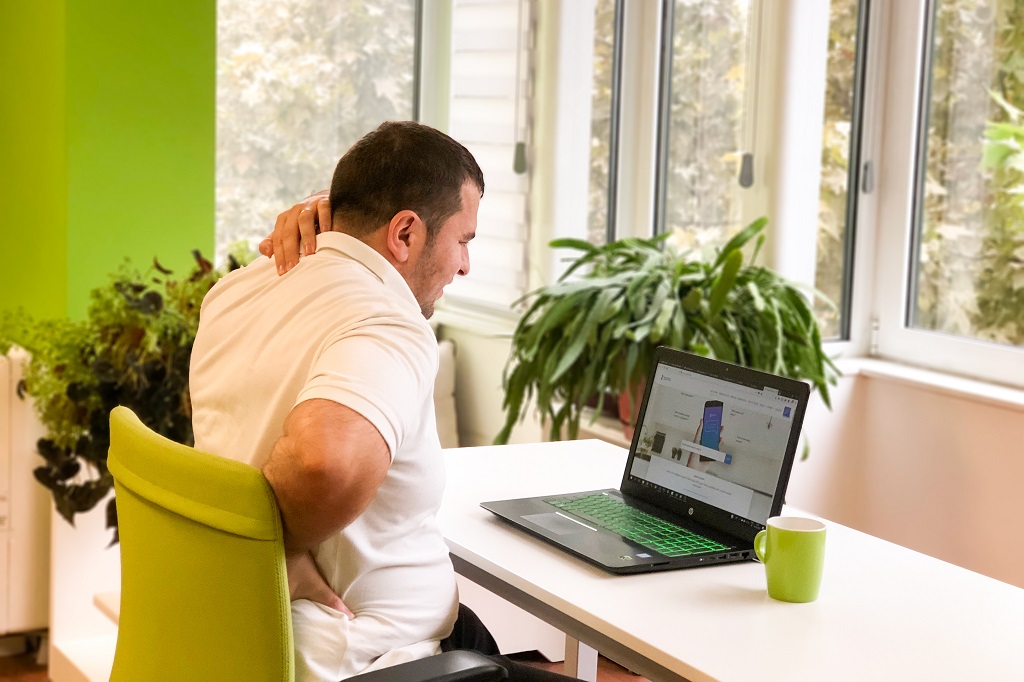Low back pain
Treatment

Treatments for back pain vary depending on how long you've had the pain, how severe it is, and your individual needs and preferences.
Back pain will usually improve within a few weeks or months. There are several things you can try to help reduce your pain in the meantime.
There are also some specialist treatments that may be recommended if it's thought simple measures aren't likely to be effective on their own.
See your GP or a physiotherapist if your pain isn't improving despite trying simple treatments.
The main treatments for back pain include:
Treatments you can try yourself
Stay active
One of the most important things you can do is to keep moving and continue with your normal activities as much as possible.
It used to be thought that bed rest would help you recover from a bad back, but it's now known that people who remain active are likely to recover more quickly.
This may be difficult at first, but don't be discouraged – your pain will start to improve eventually. Consider taking painkillers if the pain is stopping you from carrying on as normal.
There's no need to wait until you're completely pain-free before returning to work. Going back to work will help you return to a normal pattern of activity and may distract you from the pain.
Back exercises and stretches

Simple back exercises and stretches can often help reduce back pain. These can be carried out at home as often as you need to.
For information about the types of exercises and stretches that can help, see:
Your GP may be able to provide information about back exercises if you're unsure what to try, or you may want to consider seeing a physiotherapist for advice.
Doing regular exercise alongside these stretches can also help keep your back strong and healthy. Activities such as walking, swimming, yoga and pilates are popular choices.
Short-term back pain
Initially, back pain is usually treated with over-the-counter painkillers and home treatments. Most people will experience a significant improvement in their symptoms within six weeks.
Keep moving
It used to be thought that bed rest would help you recover from a bad back, but it's now recognised that people who remain active are likely to recover more quickly.
This may be difficult at first if the pain is severe, but try to move around as soon as you can and aim to do a little more each day.
Activity can range from walking around the house to walking to the shops. You will have to accept some discomfort, but avoid anything that causes a lot of pain.
There is no need to wait until you are completely pain-free before returning to work. Going back to work will help you return to a normal pattern of activity, and it candistract you from the pain.
Painkillers
Paracetamol is often one of the first medications recommended for back pain, although some people find non-steroidal anti-inflammatory drugs (NSAIDs) , such as ibuprofen, more effective.
A stronger painkiller, such as codeine, is also an option and is sometimes taken in addition to paracetamol.
Painkillers can have side effects. Some can be addictive, while others may not be suitable, depending on your health and medical history for example, the long-term use of NSAIDs can affect how well your kidneys work.
Your pharmacist or GP will be able to give you advice about the most appropriate type of medication for you.
If over-the-counter medications are not controlling your pain, your GP may be able to prescribe something stronger. They may also recommend a short course of a muscle relaxant, such as diazepam, if you experience muscle spasms in your back.
Hot and cold treatments
Some people find that heat for example,a hot bath or a hot water bottle placed on the affected areahelps ease the pain.
Cold, such as an ice pack or a bag of frozen vegetables, placed on the painful areacan also be effective.
Don't put the ice directly on to your skin though, asit might cause a cold burn. Wrap an ice pack or bag of frozen vegetables in a cloth before putting it on your skin.
Another option is to alternate between hot and cold using ice packs and a hot water bottle. Hot and cold compression packs can be bought at most pharmacies.
Relax and stay positive
Trying to relax is a crucial part of easing the painas muscle tension caused by worrying about your conditionmay make things worse.
Although it can be difficult, it's also important to stay optimistic and recognise that your pain should get better, aspeople who manage to stay positive despite their pain tend to recover quicker.
Change your sleeping position
Changing your sleeping position can take some of the strain off your back and ease the pain.
If you sleep on your side, draw your legs up slightly towards your chest and put a pillow between your legs. If you sleep on your back, placing pillows under your knees will help maintain the normal curve of your lower back.
Exercise and lifestyle
Try to address the causes of your back pain to prevent further episodes. Common causes include being overweight, poor posture and stress.
Regular exercise and being active on a daily basis will help keep your back strong and healthy. Activities such as walking , swimming and yoga are popular choices.
The important thing is to choose an enjoyable activity that you can benefit from without feeling pain.
Specialist treatments
If you have had back pain formore than six weeks (known as chronic back pain), your GP will advise you about which painkillers to take and may recommend:
- exercise classes group classes supervised by a qualified instructor, where you are taught exercises to strengthen your muscles and improve your posture, as well as aerobic and stretching exercises
- manual therapy therapies including manipulation, mobilisation and massage, usually carried out by chiropractors, osteopaths or physiotherapists, although chiropractic and osteopathy aren't widely available on the NHS
- acupuncture a treatment where fine needles are inserted at different points in the body; it's been shown to help reduce lower back pain, although it's not always available on the NHS
These treatments are often effective for people whose back pain is seriously affecting their ability to carry out daily activities and who feel distressed and need help coping.
Alexander Technique

*Photo credits © Harvard Health Publishing
There is also some evidence that a therapy called the Alexander Technique may help people with long-term back pain, although the National Institute for Health and Care Excellence (NICE) does not currently recommend this treatment specifically.
Some of the other treatments that may be recommended are described below.
Antidepressants
If painkillers do not help, you may be prescribed tricyclic antidepressants (TCAs) , such as amitriptyline. TCAs were originally intended to treat depression, but they are also effective at treating some cases of persistent pain.
If you are prescribed a TCA to treat persistent back pain, the dose is likely to be very small.
Counselling
If the treatments described above are not effective, you may be offered psychological therapy to help you deal with your condition.
While the pain in your back is very real, how you think and feel about your condition can make it worse.
Therapies such as cognitive behavioural therapy (CBT) can help you manage your back pain better by changing how you think about your condition.
Pain clinics
If you have long-term pain, you may be able to attend a specialist pain clinic.
Pain clinics help people manage their pain and provide advice about things such as increasing your activity level and how to have a better quality of life despite being in pain.
Your programme may involve using a combination of group therapy, exercises, relaxation and education about pain and the psychology of pain.
Surgery
Surgery for back pain is usually only recommended when all other treatment options have failed orif your back pain is so severe you are unable to sleep or carry out your daily activities.
The type of surgery suitable for you will depend on the type of back pain you have and its cause.
Two procedures sometimes carried out include:
- a discectomy where part of one of the discs between the bones of the spine (the vertebrae) is removed to stop it pressing on nearby nerves (known as a slipped or prolapsed disc )
- spinal fusion where two or more vertebrae are joined together with a section of bone to stabilise the spine and reduce pain
These procedures can help reduce pain caused by compressed nerves in your spine, but they are not always successful and you may still have some back pain afterwards.
As with all types of surgical procedures, these operations also carry a risk of potentially serious complications.
In some cases, nerves near the spine can be damaged, resulting in problems such as numbness or weakness in a part of one or both legs or, in rare cases, some degree of paralysis.
Before you agree to have surgery, you should fully discuss the risks and benefits with your surgeon.
Treatments not recommended
A number of other treatments have sometimes been used to treat long-term back pain, but are not recommended by the National Institute for Health and Care Excellence (NICE) because of a lack of evidence about their effectiveness in treating non-specific back pain (back pain with no identified cause).
These include:
- low level laser therapy where low energy lasers are focused on your back to try to reduce inflammation and encourage tissue repair
- interferential therapy (IFT) where a device is used to pass an electrical current through your back to try to accelerate healing while stimulating the production of endorphins (the bodys natural painkillers)
- therapeutic ultrasound where sound waves are directed at your back to accelerate healing and encourage tissue repair
- transcutaneous electrical nerve stimulation (TENS) where a machine is used to deliver small electrical pulses to your back through electrodes (small sticky patches) that are attached to your skin; the pulses stimulate endorphin production and prevent pain signals travelling from your spine to your brain
- lumbar supports cushions, pillows and braces used to support your spine
- traction where a pulling force is applied to your spine
- injections where painkilling medication is injected directly into your back
Introduction
Back pain is a common problem that affects most people at some point in their life. It may be triggered by bad posture while sitting or standing, bending awkwardly, or lifting incorrectly.
Symptoms
You should seek urgent medical help if you have back pain and a high temperature (fever), unexplained weight loss, a swelling or a deformity in your back, it's constant and doesn't ease after lying down, etc.
Causes
Your back is a complex structure made up of bones, muscles, nerves and joints. This can often make it difficult to pinpoint the exact cause of the pain.
Diagnosis
Most cases of back pain do not require medical attention and can be treated with over-the-counter painkillers and self-care. However, you should visit your GP if you are worried about your condition or struggling to cope with the pain.
Treatment
Treatments for back pain vary depending on how long you have had the pain, how severe it is, and your individual needs and preferences. Initially, back pain is usually treated with over-the-counter painkillers and home treatments.
Lower back pain exercises
There are some simple back exercises and stretches you can do at home to help ease lower back pain and improve your strength and flexibility.
Prevention
Keeping your back strong and supple is the best way to avoid getting back pain. Regular exercise, maintaining good posture and lifting correctly will all help. How you sit, stand and lie down can have an important effect on your back.
"I've picked up my life again."
Back pain was agony for Anne Parker from Berkshire, but thanks to the right diagnosis shes now walking tall. My bad back started 12 years ago with pains in my right buttock. When I saw my GP, he said the problem was actually my back,and he gave me painkillers.
"I can continue going about my daily life."
Kiran Mohan tells his story about his struggle with back pain. "My back problems started in 1999 when I developed a severe pain in the heel of one of my feet, which gradually progressed to the other foot." he says.








 Subscribe
Subscribe Ask the doctor
Ask the doctor Rate this article
Rate this article Find products
Find products